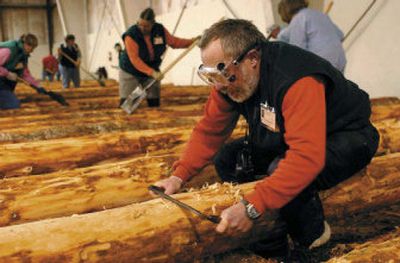Improved Fort Clatsop in works

ASTORIA, Ore. – The new Fort Clatsop will look a bit more rustic than the one it’s replacing, but it will also include some modern safety features to prevent the sort of fire that destroyed the first replica.
A design team assembled by the Lewis and Clark National Historical Park has come up with a blueprint for the new fort.
More than 400 Douglas fir logs were donated by Stimson Lumber Co., Longview Fibre Co., Hampton Affiliates and Weyerhaeuser Co. Reconstruction work kicked off Dec. 10, the 200th anniversary of the day the expedition started work on the original fort.
The fire that destroyed the 50-year-old replica on Oct. 3 stunned and saddened park staff, local residents, and Lewis and Clark fans across the country, but it also provided an opportunity for the construction of a new fort that more closely resembles what the expedition’s winter encampment probably looked like.
The design effort attempted to balance historical authenticity with modern concerns for safety and durability, while creating an icon as enduring as the original replica.
“The fort built in the 1950s was very successful because it really connected people to the story,” said Chip Jenkins, Lewis and Clark park superintendent. “I told Pete our goal is to be that successful.”
Project manager Pete Field said the designers used the plans of the first replica as a starting point, then combed through the Lewis and Clark journals, eyewitness accounts from people who visited the fort after the explorers’ departure and more recent scholarly research for information on the fort’s likely appearance.
It was long accepted that the first replica, constructed by the local Jaycees and other service clubs with mostly volunteer labor, was probably much more expertly crafted than the one Lewis and Clark’s wet, tired men threw together in a few weeks in December 1805.
“We’ve been consistently hearing if we could make it look more rustic,” Jenkins said of the new replica.
The new Fort Clatsop will be built on the old replica’s footprint, even using the original concrete footings, with the same number of rooms and the same roofline. But there will be changes.
For starters, the ends of the logs where they meet at the building’s corners will be fashioned to appear as if they were cut with axes, versus the cleanly cut logs on the original replica, and will be staggered instead of neatly lined up, Field said.
And chinking will be placed in between the logs, much like the original fort had, although a modern substance will be used instead of the mud of 1805, he said.
The first replica used 50-foot logs on the outer walls, but the team decided logs that big would have been difficult for Lewis and Clark’s men to put into place, and instead they are using logs no more than 20 feet long, Field said.
Many think the expedition didn’t even bother to peel the bark off the logs used in the original fort. But the logs in the new replica will be peeled, mostly because that’s the only way they can be pressure-treated, Field said.
The new fort will also include some modern fixtures, most notably a fire-detection and suppression system. The warning system will automatically notify the local 911 center of a fire’s location, and the suppression system, likely to be water-based sprinklers, will be capable of controlling the fire long enough for fire crews to arrive.
The old replica had no detection system, which resulted in firefighters driving around the area the night of the fire before they were able to discover the blaze was at Fort Clatsop.
The fort will contain fireplaces and fire pits just like the old replica, but the fixtures will be built with modern materials and designs, the fire pits will be screened and portions of the adjacent floor will also be built with fireproof materials, Field said.
A stray ember from a fire in one of the fire pits is believed to be the cause of the October fire.